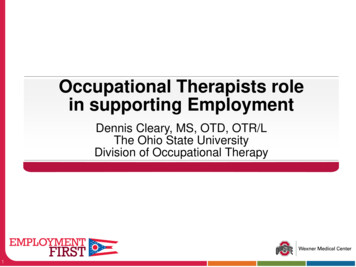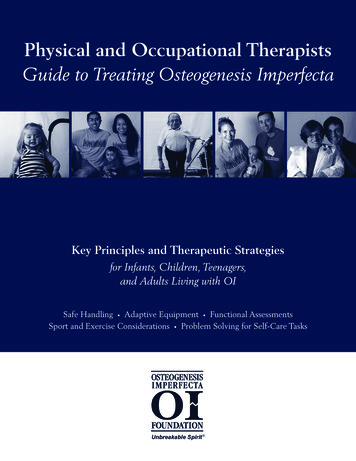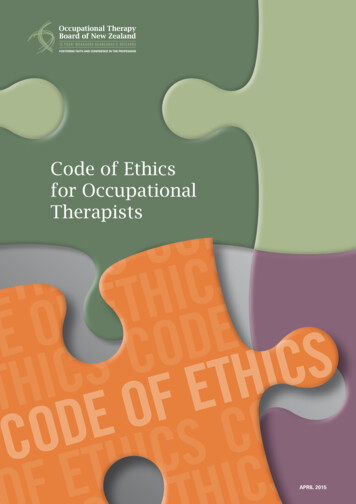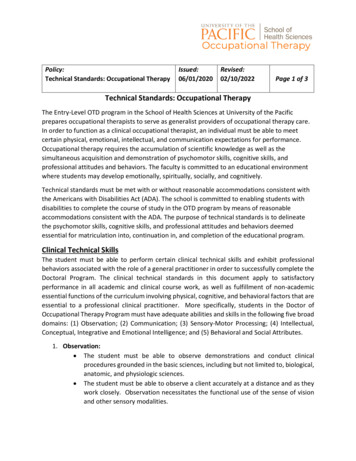
Transcription
Occupational Therapists rolein supporting EmploymentDennis Cleary, MS, OTD, OTR/LThe Ohio State UniversityDivision of Occupational Therapy1
After today you will be able to 1. Identify the scope of practice of OccupationalTherapy in supporting individuals with IDD inemployment.2. Describe how to access occupational therapyservices in schools and community settings.3. List best practices in Occupational Therapy tosupport employment for those with intellectualdisabilities.4. Use the Occupational Therapy Process to analyzeworkplace problems.
MonthTrainings available at Ohioemploymentfirst.orgwebsiteJune 30, 2014Task analysis for job coachesJuly 21, 2014Worksite Analysis for job coachesAugust 28, 2014Tablet Computers and Smartphones as workplace supportsSeptember 23, 2014January 26, 2015The Role of the Occupational Therapist in supportingemploymentThe Role of Rehab Engineering and the Assistive TechnologyCenter in supporting employmentVideo Resumes and Professional Portfolios: Presenting JobSeekers in the best lightAugmentative Communication Devices as employment supports.February 26, 2015Employment supports for those with IDD and Autism.March 16, 2015Employment supports for those with Physical or Sensoryinvolvement.The Job Matching ProcessOctober 27, 2014November 20, 2014April 28, 20153
Previous Presentations: Ohioemploymentfirst.org
Handouts This PresentationAddress list for OT and OTA Programs in OhioTransitions Checklist (AOTA)OT’s Role in Employment of Young Adults
Free Occupational TherapyConsultation right now typea question for Stacy!6
Background on Employment About 3% (9 million people) of the Americanpopulation lives with an intellectual disability (ID)1 Birth – 21, IDEA – iesAll DisabilitiesGeneralPopulationPost HS Education29%60%67%Post HS Employment39%60%66%2 Total lifetime costs (healthcare, support services, lostproductivity) 1 million per individual with ID31Administration on Intellectual and Developmental Disabilities, 20122Newman et al., 2011; Bureau of Labor Statistics, 20123Centers for Disease Control and Prevention, 2006
Importance of Employment Work is fundamental tohuman identity1 Work is closely related toSocioeconomic status 2Quality of Life,3 and Health 4 Work provides structure toview the world and participatein life 51Corcoran, 20042 Butterworth et al., 20123 Eggleton et al., 19994 Petrovski & Gleeson, 19975 Daston, Riehle, & Rutkowski, 2012
Occupational Therapy Has a strong history in Employment (1917) Roots of the profession are in helping soldiers findmeaning and develop employment skills after WorldWars I and II You are probably most familiar with our role in theschools, county boards, or in industrial rehabilitationprograms (FCEs)
What do OTs do? Occupational therapists prevent illness, remediatedisability, and restore health by enabling participationin meaningful occupations
“Occupations,” you mean jobs,right? Well yes and no!OTs use the term occupation in the following way,occupations are:Activities of everyday life, named, organized,and given value and meaning by individualsand a culture. Occupation is everything peopledo to occupy themselves, to look afterthemselves or others
Areas of Occupation1. Activities of Daily Living2. Work, Education, & Other ProductiveActivities3. Play & Leisure
6400 Occupational Therapists andOccupational Therapy Assistants in OhioOTR/L or OT/L Occupational Therapist Registered/Licensed BA, MS, MOT, OTDCOTA/L or OTA/L OT Assistant Certified/Licensed Two year community college degree The COTA needs to be supervised by anOccupational Therapist to use the COTAcredential or bill for OT services
OT Graduate School CoursesAnatomyPhysiologyActivity sionPediatricsMedical TermsKinesiologySplintingSensory ical SkillsMedicationsLifestyle Redesign1100 hours of Supervised PracticeNational Certification ExaminationState Licensure
Person– Environment – OccupationPerson(Teach new upation(Modify the task)
Typical pattern of OT Intervention forsomeone with IDD over a lifetime Early InterventionPre-SchoolGrade schoolMiddle SchoolHigh SchoolTransitionAdultWhy OT is less involved in employment1. Transitions handled by others2. Occupational Therapy’s role notunderstand by team3. Lack of financial resourcesKardos, M., & White, B. P., (2005). The role of the school-based occupational therapist in secondary educationtransition planning: A pilot survey study. American Journal of Occupational Therapy, 59, 173-180Mankey, T. A. (2011). Occupational Therapists' Beliefs and Involvement with Secondary Transition Planning. Physical& Occupational Therapy In Pediatrics, 31(4)Shattuck, P. T., Wagner, M., Narendorf, S., Sterzing, P., & Hensley, M. (2011). Post–high school service use amongyoung adults with an autism spectrum disorder. Archives of pediatrics & adolescent medicine, 165(2), 141-146.
O-H-I-O
Approaches used by OT1. Assess and adapt the environment:2. Task Analysis: Increase efficiency3. Skill building: Technology and tool use,community travel.4. Functional living skills training: Cooking,hand washing, dressing, work!5. Physical skills: Strength, coordination6. Sensory and Sensory motor adaption: Adaptroutines, modify environments
How are OT services delivered? Direct services Evaluation One-on-one, groups Indirect Services (CONSULTATION) Consulting with Job Coach/IndividualWorksite Evaluations and recommendationsStaff TrainingSupervision of OT assistantMonitoring progress TeleHealth!
Where are services provided? Depends on the setting 1. On site.2. In an Occupational Therapy clinic3. TeleHealth (depends on statelicensure laws)
Access to an Occupational Therapistin your setting?1. Public Schools2. County Board of Developmental Disabilities3. Community Agency- OOD Funding- Waiver Funding- Personal Health Insurance
Brown Mackie (Akron) Brown Mackie (Findlay) Cincinnati State Cleveland State Cuyahoga Community EHOVE Adult Career Center Kent State (East Liverpool) Kent State (Ashtabula) Kettering College Marion Technical College North Central State Owens Community Rhodes State College Shawnee State University Sinclair Community College Stark State College The Ohio State University The University of Findlay The University of Toledo Xavier University Zane State CollegeScarlett – OTR, Grey - OTA22
Why do you need an Occupational Therapist on your team?23
Best Practices in Occupational Therapy toSupport Employment1.2.3.4.5.6.Early, paid work experienceindividual involvement in transition planningEmphasis on individual’s social competenceDevelopment of life skillsUse of assistive technologyCollaborative interdisciplinary and interagencyteamworkIDEA, 2013; Lieberman, 2002
Self Determination Self-determined individuals: Demonstrate self-awareness and self-advocacyMake choices and decisionsProblem-solve when issues ariseAchieve self-identified goals Occupational therapists work with individualsto improve self-determination and selfadvocacy skills by using assessments tomake the individual and team aware ofstrengths, weaknesses, goals and needs, aswell as providing direct instruction on how toself-advocateMcConnell et al., 2012; Wagner, Newman, Cameot, Javitz, & Valdes, 2012; Wehman, 2013; Wehmeyer & Shogren, 2013
Emphasis on Social Competence Social competence: individual’s effectiveness innavigating interpersonal relationships with others atwork, school, home, or in public situations Subjective in nature, and changes given the context Social demands can be complicated andoverwhelming for individuals with disabilities, who areless likely to have the opportunities learn, practice,and develop social competenceOrsmond, Shattuck, Cooper, Sterzing, & Anderson, 2013; Reichow & Volkmar, 2010
Emphasis on Social Competence Evidence suggests that those with higher level socialskills are more likely to be employed Occupational therapists work with clients to improvetheir social skills through:1. Direct instruction Includes training in various communication devices2. Peer awareness Peer mentoring and positive peer pressure3. Involvement and accommodation4. Positive climate of integration and encouragement Emphasis on inclusion in businesses and other organizationsTest et al., 2009 Bedesem & Dieker, 2013 Blood et al., 2011 Carter et al., 2012, Alquraini & Gut, 2012, Stanish & Temple, 2012 Bennett & Gallagher, 2013
Development of Life Skills Life skills curriculum is designed to facilitate the developmentof skills that are necessary for success in adult life; designedas an alternative to traditional academic curriculum Acceptability of this as a valid curricular choice varies due topossible violations of federal guidelines (IDEA 2004, NCLB2001) Important option for individuals in transition, especially thosewhose primary target is employment and not education Considerations for occupational therapists1. ALL individuals must learn and master independent living skills2. Functional life skills curriculum is a legitimate option3. Functional curriculum may be more appropriate than anacademic curriculum for some individuals4. Use of assistive technologies may prove beneficial inpromoting independence and can contribute to the functionalcurriculumBouck, 2013
Use of Assistive Technology Assistive technology can foster participation Commercially available technology very useful insupporting individuals in transition; can becustomized to meet an individual’s needs Tablets and smartphones are used by those withand without disabilities; these are tools ofinclusion Supports for academics and competitive employment
Smartphones and Tablets!Previous Presentations: Ohioemploymentfirst.org
Assessments AIR Self-Determination Assessment American Institutes for Research and Columbia University ARC Self-determination scales And Procedural Guide Morningstar, M. E., Frey, B. B., Noonan, P. M., Ng, J., Clavenna-Deane, B.,Graves, P., . & Williams-Diehm, K. (2010). A preliminary investigation of therelationship of transition preparation and self-determination for students withdisabilities in postsecondary educational settings. Career Development forExceptional Individuals, 33(2), 80-94. FATCAT Dr. Tony Gentry Functional Assessment Tool for Cognitive Assistive Technology Virginia Commonwealth University Bright Futures Service Menu Dr. Deborah Davidson
OT in Work Learn about skills for jobs I am interested in Create a resume Apply for jobs Volunteer for community agencies Learn about work habits and attitudes for keeping a job Practice the speaking skills for a job interview Explore different careers based on my interests, goals, and abilities Receive support or coaching on the job or volunteer site Have a consultant to work with my employer Start my own business Learn about workplace accommodations and/or job taskmodifications
OT in Education Organize my academic or work life Choose a course of study and/or institution Establish study habits needed for college Follow a schedule or routine Increase computer, email, or technology skills Use the internet to find information Use a planner or calendar to stay organized Better coordinate my educational services/ accommodations Find a peer mentor at my school Establish a transition plan for leaving or entering school
OT in Living Skills Create a routine for daily living Live on my own Improve my self care or personal hygiene Use a bank account, budget, and pay bills Take care of my home (chores, minor repairs, etc.) Do my own laundry Manage my own medicines Cook my own hot meals Use public transportation Learn to drive Plan a week of meals Work on childcare, pet care, of care of others
OT in Personal Health & Wellness Make healthier food choicesLearn about energy conservationEstablish an exercise routineSet goals for myselfFind a doctor who takes care of my health needsFind a lawyer to assist with long term planning orguardianship Find a counselor to help with my mental healthneeds Learn about how to disclose my disability in differentsituations (work, school, personal)
April 28, 2015OT’S ROLE IN JOB MATCHING
WorkOrientedWorkerOriented37“Does the job require ”“How often does ”“Can you ”“Is the person able to ”
WorkOrientedWorkerOrientedThingsPhysical SkillsPhysical tasksFlexibilityPhysical demandsBending overBending and twistingRepeatedlyWeeding a garden1 hourConcept credit: Personnel Systems & Technologies Corporation38
WorkOrientedThingsPhysical tasksPhysical demandsBending and twistingWeeding a garden39Work:PeopleWorkerOrientedPhysical SkillsFlexibilityBending overRepeatedly1 hour
Work:PeopleThingsPhysical tasksPhysical demandsBending and twistingWeeding a garden40Physical SkillsTask AbilitiesTask PreferencesPhysical EnvironmentSocial EnvironmentFlexibilityBending overRepeatedly1 hour
Novel Approach for Job Matching Systematic Data – driven Analytical Our long-term goal is to improve employmentoutcomes for individuals with disabilities throughsystematic assessment and intervention techniques41
How Can OT help?42
OT Intervention1. What does the employee need to learn, orwhat must change to encourage success?2. Which Strategies will facilitate learning?3. Who is needed to accomplish this?4. How Should intervention be provided? Direct Service, Consultation, Staff training5. Which Methods will I use to translate myknowledge to others?43
Strategies and Methodsof OT InterventionStrategies1. Teach New SkillMethod1. Modeling2. New Equipment3. Modify Environment4. Help w/ Perspective2. Direct Instruction3. Encouragement4. Provide Resources5. Change Schedule
OT Intervention Strategies1. Teach New Skill2. New Equipment3. Modify Environment4. Help w/ Perspective5. Change Schedule45
OT Intervention Methods1. Modeling2. Direct Instruction3. Encouragement4. Providing Resources46
Stages of ConsultationEntry – aim for equity, realize agendasIssue Definition – you are a visitor, theproblem is different to each person3. Recommendations more likely followed It is easy and convenient Minimal interruption to the schedule The level of effort is ‘doable’ They understand the ‘Why’ It is effective4. Concluding – did it work? Are Revisionsneeded?1.2.Hanft, B. and Shepherd, J. (2008). Collaborating forStudent Success: A Guide for SchoolBased Occupational Therapy. Bethesda,MD. AOTA Press.47
Strategies and Methodsof OT InterventionStrategies1. Teach New SkillMethod1. Modeling2. New Equipment3. Modify Environment4. Help w/ Perspective2. Direct Instruction3. Encouragement4. Provide Resources5. Change Schedule
For Questions about this or to registerfor future presentationsEmploymentfirst@Dodd.ohio.govFor Occupational Therapy CEU’splease contactChristopher.Brown@osumc.edu49
ReferencesAlquraini, T., & Gut, D. (2012). Critical components of successful inclusion of individuals with severe disabilities: Literature review. International Journal of SpecialEducation, 27(1), 42-59.American Occupational Therapy Association. (2006). Transforming caseload to workload in school-based and early intervention occupational therapy services.Retrieved from http://www.aota.orgBedesem, P. L., & Dieker, L. A. (2013). Self-monitoring with a twist: Using cell phones to monitor on-task behavior. Journal of Positive Behavior Interventions.Bennett, S., & Gallagher, T. (2013). High school individuals with intellectual disabilities in the school and workplace: Multiple perspectives on inclusion. CanadianJournal of Education/Revue canadienne de l’éducation, 36(1), 96-124.Bennett, K. D., Gutierrez, A., & Honsberger, T. (2013). A comparison of video prompting with and without voice-over narration on the clerical skills of adolescentswith autism. Research in Autism Spectrum Disorders, 7(10), 1273-1281.Blood, E., Johnson, J. W., Ridenour, L., Simmons, K. & Crouch, S. (2011). Using an iPod touch to teach social and self-management skills to an elementaryindividual with emotional/behavioral disorders. Educations and Treatment of Children, 34(3), 299-321.Bouck, E. C. (2013). Secondary curriculum and transition. In P. Wehman (Ed.), Life beyond the classroom:Transition strategies for young people with disabilities(pp. 215-234). Baltimore, MD: Paul H. Brookes Pub. Co.Butterworth, J., Smith, F. A., Hall, A. C., Migliore, A., Winsor, J., Domin, D., & Timmons, J. C. (2012). StateData: The national report on employment services andoutcomes. Boston, MA: Institute for Community Inclusion (UCEDD), University of MassachusettsBoston.Carter, E. W., Austin, D., & Trainor, A. A. (2012). Predictors of postschool employment outcomes for young adults with severe disabilities. Journal of DisabilityPolicy Studies, 23(1), 50-63.Cason, J., & Richmond, T. (2013). Telehealth opportunities in occupational therapy. Telerehabilitation (pp. 139-162) Springer.Clayton, K. S., & Chubon, R. A. (1994). Factors associated with the quality of life of long-term spinal cord injured persons. Archives of Physical Medicine andRehabilitation, 75(6), 633-638.Corcoran, M. A. (2004). Work, occupation, and occupational therapy. The American Journal of Occupational Therapy: Official Publication of the AmericanOccupational Therapy Association, 58(4).Eggleton, I., Robertson, S., Ryan, J., & Kober, R. (1999). The impact of employment on the quality of life of people with an intellectual disability. Journal ofVocational Rehabilitation, 13, 95-107.Gentry, T., Lau, S., Molinelli, A., Fallen, A., & Kriner, R. (2012). The apple iPod touch as a vocational support aid for adults with autism: Three case studies.Journal of Vocational Rehabilitation, 37(2), 75-85.Holburn, S. & Vietze, P. M. (2002). Person-centered planning: Research, practice, and future directions. Baltimore, MD: Brookes.
ReferencesHolm, M. B., & Raina, K. D. (2012). Emerging technologies for caregivers of a person with a disability. Multiple dimensions of caregiving and disability (pp.185-208) Springer.Idea Partnership (2013a). Needs of the field. Retrieved from -Collection/ccc needs-of-field.pdfIdea Partnership (2013b). Grounding assumptions. Retrieved from -Collection/ccc groundingassumptions.pdfIdea Partnership (2013c). The partners. Retrieved from ea Partnership (2013d). The partnership way. Retrieved from s/the-partnership-way.htmlInge, K. J. (1988). Quality of life for individuals who are labeled mentally retarded: Evaluating competitive employment versus sheltered workshopemployment. Education and Training in Mental Retardation, 23(2), 97-104.Kardos, M., & White, B. P. (2005). The role of the school-based occupational therapist in secondary education transition planning: A pilot survey study.American Journal of Occupational Therapy, 59, 173-180.Kober, R., & Eggleton, I. R. C. (2005). The effect of different types of employment on quality of life. Journal of Intellectual Disability Research, 49(10), 756760.Kregel, J., & Dean, D. H. (2002). Sheltered work vs. supported employment: A direct comparison of long-term earnings outcomes for individuals withcognitive disabilities. In: J. Kregel, D. H. Dean, P. Wehman, Ed. Achievements and challenges in employmentservices for people withdisabilities: The longitudinal impact of workplace supports. Virginia Commonwealth University, Rehabilitation Research and Training Centeron Workplace Supports: Richmond, VA.Lieberman, D. S. J. (2002). AOTA’s evidence-based literature review project: An overview. American Journal of Occupational Therapy, 56, 344-349.Mank, D., O’Neill, C., & Jansen, R. (1998). Quality in supported employment: A new demonstration of the capabilities of people with severe disabilities.Journal of Vocational Rehabilitation, 11, 83-95.McConnell, A. E., Martin, J. E., Juan, C. Y., Hennessey, M. N., Terry, R. A., el-Kazimi, N. A., Willis, D. M. (2012). Identifying nonacademic behaviorsassociated with post-school employment and education. Career Development and Transition for Exceptional Individuals,doi:10.1177/2165143412468147Miller, A., & Dishon, S. (2006). Health-related quality of life in multiple sclerosis: The impact of disability, gender and employment status. Quality of LifeResearch, 15(2), 259-271.Mount, B. (1997). Person-centered planning: Finding directions for change using personal futures planning, 2nd ed. New York: Graphic Features.
ReferencesNewman, L., Wagner, M., Knokey, A., Marder, C., Nagle, K., Shaver, D., National Center for Special Education Research (ED). (2011). The post-high school outcomes of young adults with disabilitiesup to 8years after high school: A report from the nation longitudinal transition study-2 (NLTS2). National Center for Special Education Research.Pedretti, L. W. & Early, M. B. (2001). Occupational therapy: Practice skills for physical dysfunction. St. Louis, MO: Mosby.Petrovksi, P., & Gleeson, G. (1997). The relationship between job satisfaction and psychological health in people with an intellectual disability in competitive employment. Journal of Intellectual andDevelopmental Disability, 22(3), 199-211.Priebe, S., Warner, R., Hubschmid, T., & Eckle, I. (1998). Employment, attitudes toward work, and quality of life among people with schizophrenia in three countries. Schizophrenia Bulletin, 24(3), 469477.Orsmond, G. I., Shattuck, P. T., Cooper, B. P., Sterzing, P. R., & Anderson, K. A. (2013). Social participation among young adults with an autism spectrum disorder. Journal of Autism andDevelopmental Disorders, 43(11), 2710-2719.Reichow, B., & Volkmar, F. R. (2010). Social skills interventions for individuals with autism: Evaluation for evidence-based practices within a best evidence synthesis framework. Journal of Autism andDevelopmental Disorders, 40(2), 149-166.Revell, G., West, M., & Cheng, Y. (1997). Funding supported employment: Are there better ways? In P. Wehman, J. Kregel, & M. West, Ed. Supported employment opportunities for persons withsignificant disabilities. Richmond, VA: Virginia Commonwealth University, Rehabilitation Research and Training Center on Supported Employment.Ross, C. E., & Mirowsky, J. (1995). Does employment affect health? Journal of Health and Social Behavior, 36, 230-243.Sinnot-Oswald, M. (1991). Supported and sheltered employment: Quality of life issues among workers with disabilities. Education and Training in Mental Retardation, 26(4), 388-397.Smull, M. W., & Harrison, S. (1992). Supporting people with severe reputations in the community. Alexandria, VA: National Association of State Mental Retardation Programs.Stanish, H. I., & Temple, V. A. (2012). Efficacy o a peer-guided exercise programme for adolescents with intellectual disability. Journal of Applied Research in Intellectual Disabilities, 25(4), 319-328.Stodden, R. A., Brown, S. E., Galloway, L. M., Mrazek, S., & Noy, L. (2004). Essential tools: Interagency transition team development and facilitation.Minnesota, Institute on Community Integration, National Center on Secondary Education and Transition.Minneapolis, MN: University ofStronks, K., van de Mheen, H., van den Bos, J., & Mackenbach, J. (1997). The interrelationship between income, health and employment status. International Journal of Epidemiology, 26(3), 592-600.Test, D. W., Mazzotti, V. L., Mustian, A. L., Fowler, C. H., Kortering, L., & Kohler, P. (2009). Evidence-based secondary transition predictors for improving postschool outcomes for individuals withdisabilities. Career Development for Exceptional Individuals, 32(3), 160-181.Wagner, M., Newman, L., Cameot, R., Javitz, H., & Valdes, K. (2012). A national picture of parent and youth participation in IEP and transition planning meetings. Journal of Disability Policy Studies,23(3), 140-155. doi:10.1177/1044207311425384Wehman, P. (2013). Life beyond the classroom: Transition strategies for young people with disabilities. Baltimore, MD: Paul H. Brookes Pub. Co.Wehman, P., & Brooke, V. (2013). Securing meaningful work in the community: Vocational internships, placements, and careers. In P. Wehman (Ed.), Life beyond the classroom: Transition strategiesfor young people with disabilities (pp. 310-338). Baltimore, MD: Paul H. Brookes Pub. Co.Wehmeyer, M. L., & Shogren, K. A. (2013). Self-determination: Getting individuals involved in leadership. In P. Wehman (Ed.), Life beyond the classroom: Transition strategies for young people withdisabilities (pp. 41-68). Baltimore, MD: Paul H. Brookes Pub. Co.
3 Month Trainings available at Ohioemploymentfirst.org website June 30, 2014 Task analysis for job coaches July 21, 2014 Worksite Analysis for job coaches August 28, 2014 Tablet Computers and Smartphones as workplace supports September 23, 2014 The Role of the Occupational Therapist in supporting employment October 27, 2014 The Role of Rehab Engineering and the Assistive Technology










